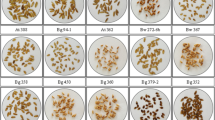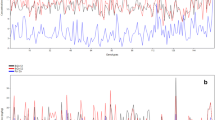Abstract
This experiment examined variation of iron (Fe) concentration in grain of local Thai rice varieties from Huai Tee Cha village, in northern Thailand. Seeds of 17 named varieties were collected from farmers in 66 accessions. Brown rice from each accession was stained individually with Perls’ Prussian blue, with IR68144 (high grain Fe) and KDML105 (low grain Fe) as checks. A wide range of grain Fe contents were found among different varieties, different seed lots with the same name and within individual accessions, notably BB, BGU and BK. The Fe concentrations in these varieties were confirmed by chemical analysis. Two accessions of each variety with most intense staining and highest average concentration of grain Fe were selected, and 20–40 seeds from each were sown for subsequent progeny testing. There was morphological variation between plants in 5 out of 6 accessions in characteristics such as pigmentation of the apiculus, pericarp and seed coat, while the sixth was externally uniform. Analysis for Fe concentration in seeds of individual lines found that the highest Fe lines were 40% to 50% higher than the lowest Fe lines. This range of grain Fe was found in all six accessions that were progeny tested, including BGU5 which was externally uniform in appearance (H′ = 0). We have shown that variation in grain Fe concentration in local Thai rice may be found between different seed lots bearing the same name and within individual seed lot as well as between varieties. This level of genetic variation may need to be considered when assessing for traits such as grain Fe for breeding programs.


Similar content being viewed by others
Abbreviations
- Fe:
-
Iron
- FDA:
-
Iron deficiency anemia
- IFPRI:
-
International Food Policy Research Institute
- WHO:
-
World Health Organization
- AFLP:
-
Amplified fragment-length polymorphism
- ISSR:
-
Inter simple sequence repeat
- SSR:
-
Simple sequence repeat
References
Allard RW (2001) Principles of plant breeding, 2nd edn. John Wiley & Sons. 264 pp
Bouis HE (1996) Enrichment of food staples through plant breeding: a new strategy for fighting micronutrient malnutrition. Nutr Rev 54:131–137
Chang TT (1976) The origin, evolution, cultivation, dissemination, and diversification of Asian and African rices. Euphytica 25:425–441
Delhaize E, Dell B, Kirk G, Loneragan J, Nable R, Plaskett D, Webb M (1984) Manual of research procedures. 1st edn. Plant nutrition research group school of environmental and life sciences, Murdoch University, Australia
Dennis JV (1987) Farmer management of rice variety diversity in Northern Thailand. Ph.D. Thesis, Cornell University, USA
Doucet MY, Viel L (2002) Alveolar macrophage graded hemosiderin score from bronchoalveolar lavage in horses with exercise-induced pulmonary hemorrhage and controls. J Vet Int Med 16:281–286
Goto F, Yoshihara T, Shigemoto N, Toki S, Takaiwa F (1999) Iron fortification of rice seed by the soybean ferritin gene. Nat Biotechnol 17:282–286
Graham RD, Senadhira D, Beebe S, Iglesias C, Monasterio I (1999) Breeding for micronutrient density in edible portions of staple food crops: conventional approaches. Field Crops Res 60:57–80
Graham RD, Welch RM (1996) Breeding for staple-food crops with high micronutrients density. International Food Policy Research Institute. 72 pp
Gregorio G (2002) A new tool for fighting micronutrient malnutrition. J Nutr 132:500s–502s
Harlan JR (1992) Crops and man. Am Soc Agron Crop Sci Soci Am, Madison, Wis, USA
IFPI, International Food Policy Research (1999) World Food Prospects: Critical issue for the early twenty-first century
IRRI-IBPGR (1980) Descriptors for rice Oryza sativa L. IRRI, P.O. Box 933, Manila, Philippines, 21pp
Juliano BO (1993) Rice in human nutrition/Prepared in collaboration with FAO. Food and Agriculture Organization of the United Nations, Rome, 162 pp
Krishnan S, Ebenezer GAI, Dayanandan P (2001) Histochemical localization of storage components in caryopsis of rice (Oryza sativa L.). Current Sci 80:567–571
Lu BR, Snow AA (2005) Gene flow from genetically modified rice and its environmental consequences. BioSci 55:669–678
Lucca P, Hurrell R, Potrykus I (2002) Fighting iron deficiency anemia with iron-rich rice. J Amer Coll Nutr 21:184S–190S
Meesin S (2003) The structure of genetic diversity in a local Thai rice germplasm, MSc Thesis (Agronomy). Graduate School, Chiang Mai University, Thailand
Meesin S, Jamjod S, Rerkasem B (2004) Variation within and between accessions of local rice variety from Thailand. Agric J (Chiang Mai University) Special Volume 2:317–326
Morishima H, Sano Y, Oka HI (1980). Observations on wild and cultivated rices and companian weeds in the hilly area of Nepal, India and Thailand. Report of a study tour in tropical Asia, 1979. Mishima, Japan: National Institute of Genetics, 97 pp
Perls M (1867) Nachweis von eisenoxyd in gewissen pigmentation. Virchows archive fur pathologische anatomie and physiologie and fur klinisch medizine 39:42–47
Phattarakul N, Jamjod S, Rerkasem B (2006) Genotypic variation of upland rice varieties in responses to aluminium toxicity in nutrient solution compared with a field study. Paper presented at the 2006 Annual Meeting of Thailand Research Fund’s Crop Science Meso. Chiang Mai University, 3–4 December 2006
Power LE, McSorley R (2000) Ecological principles of agriculture. Delmar, Thomson Learning. 433 pp
Prom-u-thai C, Dell B, Thomson G, Rerkasem B (2003) Easy and rapid detection of iron in rice grain. Science Asia 29:213–217
Prom-u-thai C, Fukai S, Godwin DI, Huang L (2007) Genotypic variation of iron partitioning in rice grain. J Sci Food Agric, In press
Prom-u-thai C, Rerkasem B (2001) Iron concentration in Thai rice germplasm. Dev Plant Soil Sci 92:351–352
Saini N, Jain N, Jain S, Jain RK (2004) Assessment of genetic diversity within and among Basmati and non-Basmati rice varieties using AFLP, ISSR and SSR markers. Euphytica 140:133–146
Senadhira D, Gregorio G, Graham RD (1998) Breeding iron and zinc dense rice. Paper presented at the International Workshop on Micronutrient of Rice for Developing Countries, Philippines
Shannon CE, Weaver W (1949) The mathematical theory of communication. The University of Illinois press, Urbana. 117 pp
Shishido R, Kikuchi M, Nomura K, Ikehashi H (2006) Evaluation of genetic diversity of wild rice (Oryza rufipogon Griff.) in Myanmar using simple sequence repeats (SSRs). Resour Crop Evol 53:179–186
Sirabanchongkran A, Rerkasem K, Yimyam N, Boonma W, Coffey K, Pinedo-Vasquez M, Padoch C (2003) Varietal Turnover and Seed Exchange: Implications for Conservation of Rice Genetic Diversity On-Farm. IRRN 29:18–20
Tin HQ, Berg T, Bjørnstad Å (2001) Diversity and adaptation in rice varieties under static (ex situ) and dynamic (in situ) management – A case study in the Mekong Delta, Vietnam. Euphytica 122:491–502
Vasconcelos M, Datta K, Oliva N, Khalekuzzaman M, Torrizo L, Krishnan S, Olivera M, Goto F, Datta SK (2003) Enhanced iron and zinc accumulation in transgenic rice with the ferritin gene. Plant Sci 164:371–378
Watabe T (1967) Glutinous rice in Northern Thailand. The Center for Southeast Asian Studies, Kyoto University, Japan. 160 pp
World Health Organization (2002) The world health report, World Health Organization, Geneva, Switzerland
Yimyam N (2006) Fallow regeneration and upland rice yield variation in a system of shifting cultivation with pada (Macaranga denticulata (Bl.) Muell. Arg) as the fallow enriching species in Northern Thailand. Ph.D. Thesis, Graduate School, Chiang Mai University
Zeven AC (1999) The traditional inexplicable replacement of seed and seed ware of landraces and cultivars: a review. Euphytica 110:181–191
Zhang Q, Saghai M, Lu TY, Shen B (1992) Genetic diversity and differentiation of indica and japonica rice detected by RFLP analysis. Theor Appl Genet 83:495–499
Acknowledgements
We acknowledge financial support from the Collaborative Crop Research Program of the McKnight Foundation and Thailand Research Fund. We thank Professor Shu Fukai for editorial suggestion and farmers of Huai Tee Cha village for making available their rice seeds for our studies. KDML105 was supplied by the Thai Rice Department, and IR68144 by IRRI.
Author information
Authors and Affiliations
Corresponding author
Rights and permissions
About this article
Cite this article
Pintasen, S., Prom-u-thai, C., Jamjod, S. et al. Variation of grain iron content in a local upland rice germplasm from the village of Huai Tee Cha in northern Thailand. Euphytica 158, 27–34 (2007). https://doi.org/10.1007/s10681-007-9421-7
Received:
Accepted:
Published:
Issue Date:
DOI: https://doi.org/10.1007/s10681-007-9421-7




